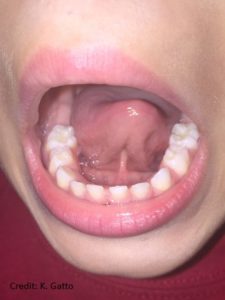By Melanie Potock, MA, CCC-SLP
 I’m in the trenches. I’m the one holding a mom’s hands while she tears up and asks me why her baby can’t eat solid foods after the GI test results can’t pinpoint a problem. I’m having delicate, respectful discussions with physicians, but who insist that “If the baby can bottle feed with that tongue, then they can learn to eat solids with that tongue” or worse, “Don’t worry if he can’t breast feed, he’ll be eating solids soon and won’t need the breast.” I’ve had preschoolers finally end up on my caseload after seeing several different medical professionals (including geneticists), but never a feeding professional. It’s what spurred me on to write three articles for the American Speech Language Hearing Association – Just Flip the Lip and Tip Back the Tongue. Later, I shared my clinical observations in the article Three Structures in A Child’s Mouth that Can Cause Picky Eating.
I’m in the trenches. I’m the one holding a mom’s hands while she tears up and asks me why her baby can’t eat solid foods after the GI test results can’t pinpoint a problem. I’m having delicate, respectful discussions with physicians, but who insist that “If the baby can bottle feed with that tongue, then they can learn to eat solids with that tongue” or worse, “Don’t worry if he can’t breast feed, he’ll be eating solids soon and won’t need the breast.” I’ve had preschoolers finally end up on my caseload after seeing several different medical professionals (including geneticists), but never a feeding professional. It’s what spurred me on to write three articles for the American Speech Language Hearing Association – Just Flip the Lip and Tip Back the Tongue. Later, I shared my clinical observations in the article Three Structures in A Child’s Mouth that Can Cause Picky Eating.
From my perspective, I can’t wait for the research on ankyloglossia (tongue-tie) in order to further determine how tethered oral tissues might be impacting an individual child’s functional skills for feeding. As a professional, I have the utmost respect for evidence based practice. If I child can’t move his tongue adequately for safe chewing and swallowing, it’s my job to determine why, with or without a study. Problem is, that child can’t wait for multiple studies to support what I see in plain sight as an experienced clinician. I’m going to consider all the possibilities impacting a child’s ability to eat in an age-appropriate manner using my differential diagnosis skills. I don’t see tethered oral tissues in all my clients, but the ones that are clearly tied can’t manipulate food safely. It may not be the only culprit, but I’m not going to ignore what’s right in front of me.
Would we question an occupational therapist’s clinical observations if they reported that a child’s fine motor skills were delayed due to syndactyly (webbing of the fingers)? Would we expect that OT to provide months of therapy to rule out other causes for the child’s motor challenges before discussing their clinical observations with the pediatrician, hand surgeon or other members of that child’s team? Would we question a physical therapist’s clinical observations if they reported that a child’s gross motor delay was related to progressive heel-cord contractures? At some point, it comes down to clinical experience and knowledgeable assessment skills, an understanding of typical development, a respect for the family’s concerns and frankly, decent eyesight.
On one hand, I can’t wait for the research! I want to learn more! We need it, but for now, I’m in the trenches.
In short, I can’t wait for the research because it’s not fair to these families. My job is to assess function for feeding. It’s pretty clear to me when I’m evaluating a child’s oral motor skills and her tongue has limited range of movement because of a tie. As a feeding specialist, I know the range of movement necessary for safe and comfortable eating. I can’t wait for the research and I think that’s enough of a reason to speak up and help these kids.
To learn what research we do have, and what we know so far, check out this post on the Talk Tools website, as well as their new book being released soon!
Functional Assessment of Feeding Challenges in Children with Ankyloglossia by Robyn Merkel-Walsh, MA, CCC-SLP & Lori Overland, MS, CCC-SLP, C/NDT, CLC. In this excellent article highlighting Walsh and Overland’s presentation at the 2017 American Speech Language Hearing Association, the following references were provided:
References:
American Academy of Breastfeeding Medicine (AABM). (2016). Protocol # 11: Guidelines for the evaluation and management of neonatal ankyloglossia and its complications in the breastfeeding dyad. Retrieved from: http://www.bfmed.org/Media/Files/Protocols/ankyloglossia.pdf
Amir, L.H., James, J.P. & Donath, S.M. (2006). Reliability of the Hazelbaker assessment tool for lingual frenulum function. International Breastfeeding Journal, 1(3).
American Speech-Language-Hearing Association (2015). ICD-10-CM Diagnosis Codes for Audiology and Speech-Language Pathology Preparing for Implementation. Retrieved from: http://www.asha.org/Practice/reimbursement/coding/ICD-10/
Boyd, K. (2014). Impact of tongue-tie over a lifetime: an anthropological perspective. Presentation at the IATP 2nd World Summit. Montreal, Quebec.
de Castro Martinelli, R.L., Marchesan, I.Q., Gusmao, R.J., de Castro Rodrigues, A. & Berretin-Felix, G. (2014). Histological characteristics of altered human lingual frenulum. International Journal of Pediatrics and Child Health, 2, 5-9.
Ferres-Amat, E., Pastor-Vera, T., Ferres-Amat, E., Mareque-Bueno, J., Prats-Armengol, J. & Ferres-Padro, E. (2016). Multidisciplinary management of ankyloglossia in childhood. Treatment of 101 cases. A protocol. Journal of Oral Medicine and Pathology, 1:21 (1):39-47
Francis, D.O., Chinnadurai, S., Morad, A., Epstein, R.A., Kohanim, S., Krishnaswami, S., Sathe, N.A. & McPheeters, M.L. (2015). Treatments for ankyloglossia and ankyloglossia with concomitant lip-tie. Comparative Effectiveness Reviews, No. 149. Agency for Healthcare Research and Quality. Retrieved from: https://www.ncbi.nlm.nih.gov/books/NBK299120/.
International Affiliation of Tongue-Tie Professionals (2016). Classification. Retrieved from: http://tonguetieprofessionals.org/about/assessment/classification/
Kummer, A. (2016). To clip or not to clip? That’s the question. Presented at the annual convention of The American Speech-Language-Hearing Association. Philadelphia, PA.
Martinelli, R.L., Marchesan, I.Q., & Berretin-Felix, G. (2012). Lingual Frenulum Protocol with Scores for Infants. International Journal of Orofacial Myology, 38, 104-113.
Merdad, H. & Mascarenhas, A.K. (2010). Ankyloglossia may cause breastfeeding, tongue mobility, and speech difficulties, with inconclusive results on treatment choices. Journal of Evidence-Based Dental Practice, 10(3):152-3.
Messner, A.H. & Lalakea, M.L. (2000). Ankyloglossia: controversies in management. International Journal of Pediatric Otorhinolaryngology, 54(2):123-31.
Overland, L. & Merkel-Walsh, R. (2013). A sensory-motor approach to feeding. Charleston, SC: TalkTools.
Sethi N., Smith D., Kortequee S., Ward V.M. & Clarke S. (2013). Benefits of frenulotomy in infants with ankyloglossia. International Journal of Pediatric Otorhinolaryngology, 77(5): 762-5.
Head’s UP! I just pre-ordered the new book by Walsh and Overland: Functional Assessment and Remediation of TOTs. You can order it here for the pre-sale price, as of today, for 50% off, on the Talk Tools website.





